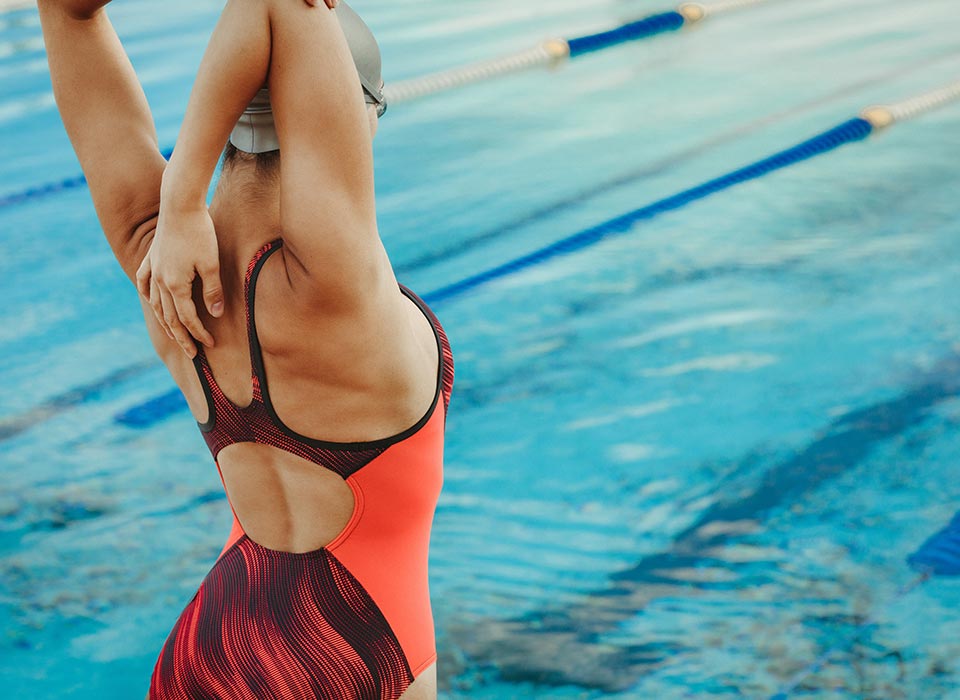The shoulder complex of the human body is one of our greatest features for both daily life and athletic competition. Designed as a ball-and-socket joint, the shoulder allows us the greatest range of movement. Unfortunately, since the shoulder is the most moveable joint, it is also one of the least stable.
Swimmers, especially competitive swimmers, often get a condition called swimmer’s shoulder. A competitive swimmer regularly swims six to eight miles a day, taking more than 4,000 strokes per workout and over a million strokes per year.
Other sports like baseball, football, tennis, and volleyball require two to three overhead shoulder movement patterns. Swimming involves several different overhead shoulder patterns in both clockwise and counterclockwise directions, which puts more stress on the joint.
What is swimmer’s shoulder?
Swimmer’s shoulder is a general term used for several different types of shoulder injuries that may develop in swimmers. The condition has a gradual onset due to the repetitive motions involved in swimming.
In most cases tired muscles cause this type of injury, but swimmer’s shoulder can also be brought on by improper stroke technique.
What is the treatment for swimmer’s shoulder?
Swimmer’s shoulder may be treated by over the counter anti-inflammatories. Physical therapy is often helpful. There are many physical therapy exercises that can be helpful to treat swimmer’s shoulder, and a physical therapist can show a swimmer how to do them safely. If the pain continues, talk with an orthopedic physician about additional treatment options.
How can I prevent swimmer’s shoulder?
“As a swimmer, it’s important to keep your rotator cuff strong so you can reduce your risk of swimmer’s shoulder,” says Ben W. Kittredge, MD, a shoulder specialist. “I advise my swimming patients to do rotator cuff exercises daily.”
Use proper technique
- Catch and pull: when your hand enters the water, you should “catch” the water with the third or fourth finger of the leading arm. If the thumb enters first, the shoulder will internally rotate which can lead to injury.
- Body rotation: thinking of your spine as a skewer, your body should rotate slightly to the right as the right arm enters the water and vice versa for the left arm. Keeping your body flat forces your shoulder to over rotate.
Be cautious stretching
- Most swimmers are not lacking in their flexibility, and many in fact are hyper-mobile.
- Avoid stretching with a partner which can often be too intense and aggressive.
- A gentle 5-10 minute warm up of your upper extremities should be enough to get the blood flowing and your muscles loose.
Pay attention to strength and conditioning
“It’s not always possible to prevent an injury but following these steps will put you in a better position to recover from swimmer’s shoulder,” says sports medicine specialist Thomas Klein, MD.
- The unstable nature of the shoulder means you need a strong scapula or shoulder blade
- Strengthening exercises can help protect your shoulder
- Protraction in 90 degrees of flexion: Lying on your back on a solid surface, push arms straight up to ceiling. Elbows should be straight and back stay flat against floor. Optional: hold up to 5 lbs in each hand
- Active resistive internal rotation: attach a resistance tube band to something sturdy about waist-height. Hold band in hand closest to that side. Keeping elbow at side, rotate arm inward across body, keeping forearm parallel to the floor. Repeat on other side.
- Push up and press up: with toes on ground, feet together, hands shoulder-width apart, and chest on floor, push up by straightening arms. continue pressing up shoulders and arching upper back. Return to start position with chest on floor.
